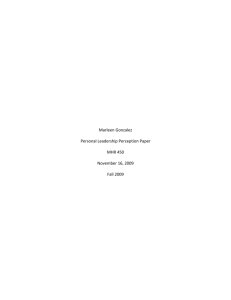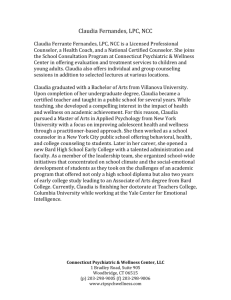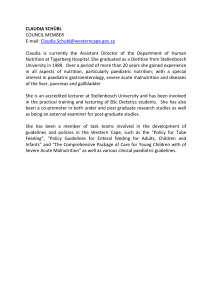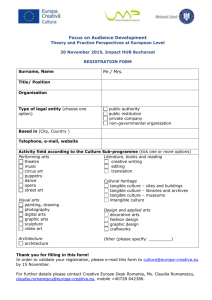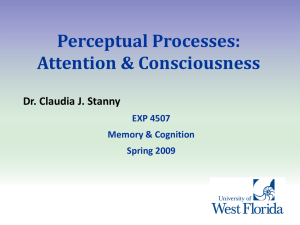Vision Audition
advertisement
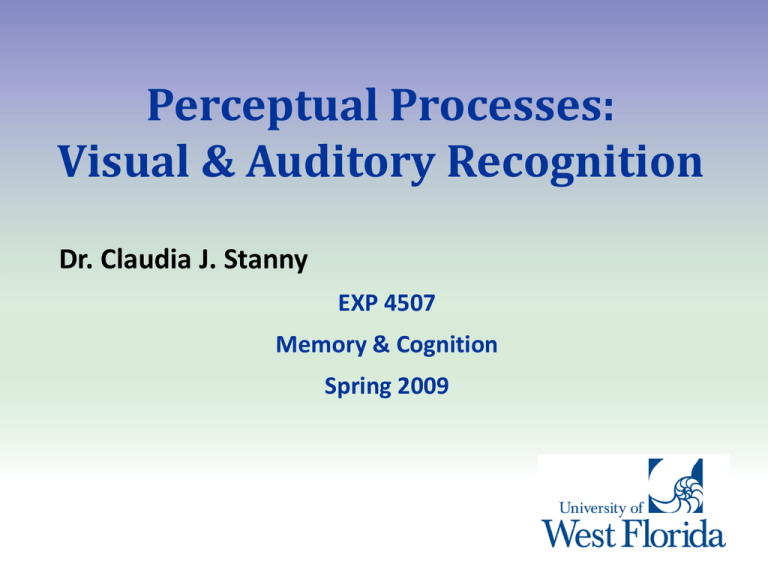
Perceptual Processes: Visual & Auditory Recognition Dr. Claudia J. Stanny EXP 4507 Memory & Cognition Spring 2009 Perception • Distal stimulus • Proximal stimulus • Sensory memory • • Iconic memory Echoic memory Claudia J. Stanny 2 Iconic Memory • Perceptually detailed visual memory • Duration is very short ( .5 sec - 1 sec) • Information stored has not been analyzed yet for meaning • Precategorical sensory information • Content can be cued effectively based on sensory qualities, not meaning Echoic Memory Auditory analog to iconic memory Precategorical auditory (sensory) information • Can cue recall of selected items based on sensory qualities but not based on meaning Very short duration (approximately 2 sec) Sensory Processes & the Brain Claudia J. Stanny 5 Gestalt Psychology: Organizing Principles in Perception Form perception Figure-ground resolution Detection of contours (subjective contours) Principles of organization • • • • • Proximity Similarity Good continuation Closure Common fate Claudia J. Stanny 6 Object Recognition • Template-matching models • Feature analysis models • Recognition-by-components models Claudia J. Stanny 7 Template-Matching Models Effective for pattern recognition for small sets of well-defined patterns Template matching used today for pattern recognition of bank codes on checks Claudia J. Stanny 8 Feature Analysis Models Selfridge (1958) Pandemonium Claudia J. Stanny 9 Feature Analysis Models Relies on simpler features for template matching Includes a system of rules for how features are combined to create specific patterns Draws on single-unit data for neurons responding to sensory input (e.g., work by Hubel & Wiesel, 1965, 1979, 2005) Claudia J. Stanny 10 Recognition-by-Components Models Similar to feature analysis models Developed for perception of 3-dimensional objects Biederman (1990) Claudia J. Stanny 11 Top-Down & Bottom-Up Processing • Bottom-up processing • Emphasis on sensory input • Raw sensory input → pattern recognition • Top-down processing • Emphasis on concepts and expectations • Expectations and context create biases to extract certain patterns from sensory input Claudia J. Stanny 12 Errors in Perception • Levin & Simons (1997, 2000) • Change blindness • Inattention blindness Claudia J. Stanny 13 Change Blindness Demonstration Links to Videos Magic Trick http://www.youtube.com/watch?v=voAntzB7EwE Harvard: Participants signing up for an experiment http://www.youtube.com/watch?v=mAnKvo-fPs0 Original Door Study (Levin & Simon, 1997) http://viscog.beckman.uiuc.edu/flashmovie/12.php Recreation of Simon’s Door Experiment http://www.youtube.com/watch?v=p1aEqBaK3aM Claudia J. Stanny 15 Face Recognition Perception of faces Prosopagnosia Claudia J. Stanny 16 Thatcher Illusion Based on tendency to process faces holistically When faces are viewed upside down, we might not detect alterations in component parts When faces are viewed right side up, these changes are easily detected 17 Speech Perception • Phoneme recognition • Detection of word boundaries • Constructive nature of speech perception • Context effects on speech recognition • Phonemic restoration • McGurck effect Claudia J. Stanny 18 Theories of Speech Perception • Speech perception as a special mechanism of the brain • Speech perception as characteristic of general perceptual mechanisms Claudia J. Stanny 19

